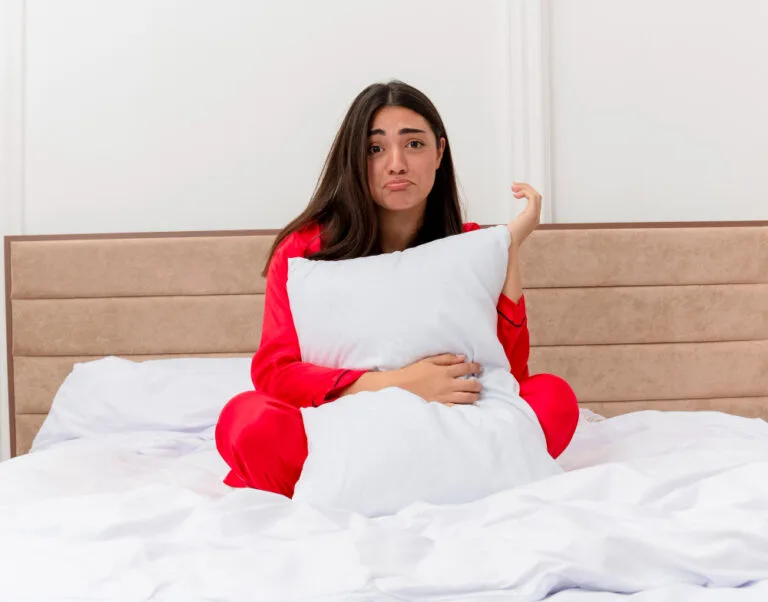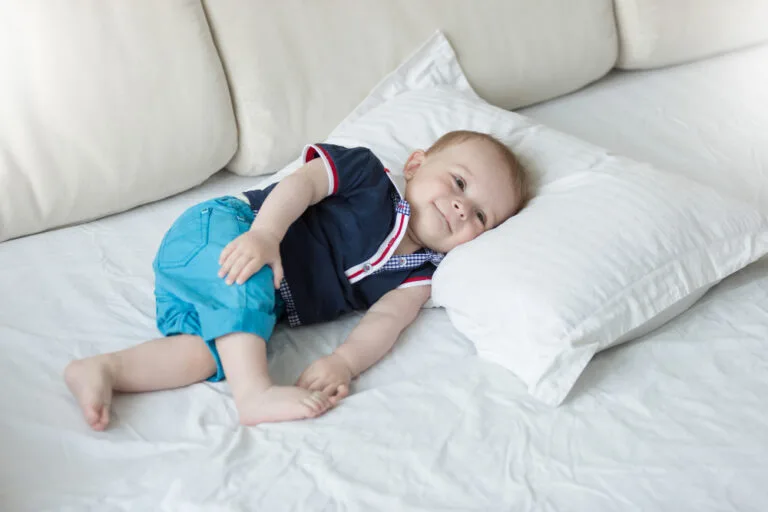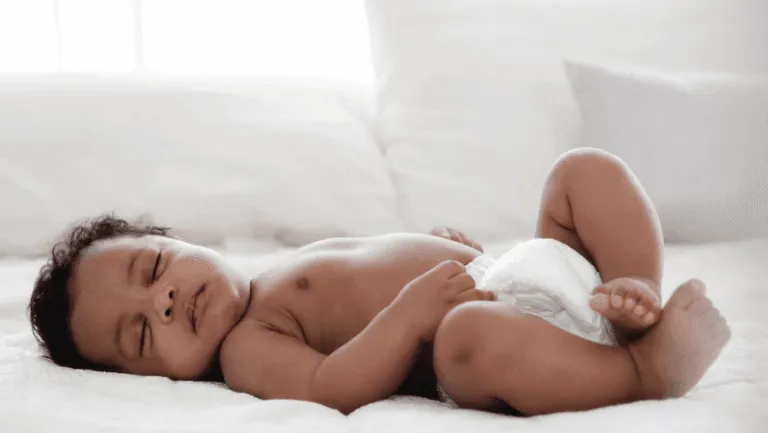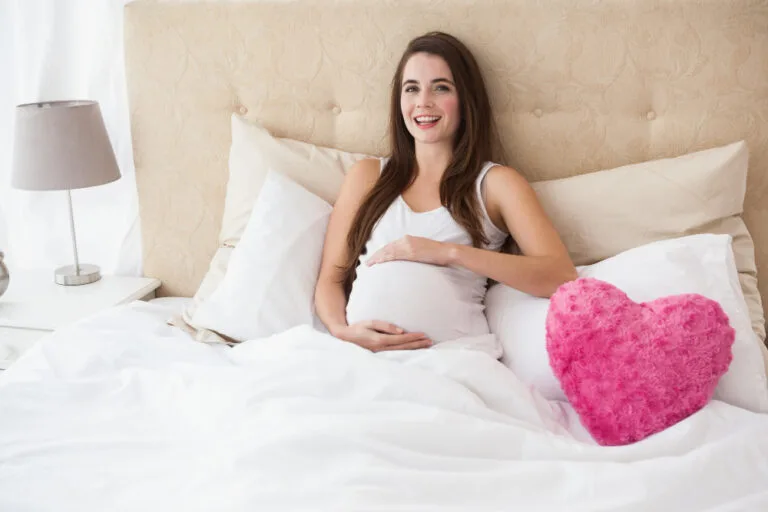It’s tough for parents to decide when to give their toddler a pillow. They think about the role of pillows in their child’s growth. But, they’re also worried about safety and comfort. Our guide shares advice and tips from experts. It tells parents when it’s okay for toddlers to use pillows and what advantages they bring.
The American Academy of Pediatrics says toddlers under two shouldn’t use pillows. Giving a pillow too early might lead to suffocation or other health problems. Yet, the right pillow can make a big difference in a child’s sleeping. This guide hopes to make the transition clear. It gives parents the info they need for a safe step into toddler pillow use.
Key Takeaways
- The safe age for a toddler to use a pillow is around two years old.
- Introducing a pillow too early can increase the risk of suffocation in toddlers.
- Choosing a pillow with hypoallergenic and non-toxic materials can reduce health risks.
- Machine washable pillows are practical for maintaining a clean sleep environment.
- Signs that a toddler is ready for a pillow include showing interest in pillows and cuddling under blankets during activities.
Introduction to Toddler Pillow Safety
It’s vital for toddlers to sleep safely. The American Academy of Pediatrics says don’t use pillows with kids under 2. This advice, along with toddler pillow guidelines, helps parents. It guides them in choosing the right sleep items for their children.
Importance of Safe Sleep Practices
Safe sleep practices help avoid Sudden Infant Death Syndrome (SIDS) and suffocation. Removing pillows, blankets, and toys from cribs cut SIDS cases by 80%. It’s key not to use a pillow with kids under 12 months. They are a suffocation risk. Once they move to a bigger bed, pillows are safer to use.
Overview of Pillow Use in Toddlers
The move from crib to bed is a big step. Toddlers should wait until they’re 2 before having a pillow, as the AAP advises. The right toddler pillow is small, firm, and supports the neck well. It’s important to choose materials that are hypoallergenic and untreated. This prevents allergies and makes sleep safer for kids.
Knowing when to introduce a pillow is crucial for a toddler’s safety. Keeping to toddler pillow safety tips means pillows add to their health. Good sleeping habits are the best way to avoid dangers of pillow use.
| Age Group | Recommendations |
|---|---|
| Under 12 Months | No pillows, blankets or toys in the crib |
| 12-24 Months | Consider not using pillows; if used, ensure supervision |
| Over 24 Months | Can introduce small, firm pillows if transitioned to a bed |
Recommendations by Pediatricians
Pediatricians often remind parents to keep a child’s sleep area safe. They say it’s key to know when it’s okay to give a child a pillow for sleeping.
American Academy of Pediatrics Guidelines
The American Academy of Pediatrics (AAP) has important rules. They say kids under 2 should not sleep with pillows. This helps lower the chance of Sudden Infant Death Syndrome (SIDS) by 80% when things like pillows, blankets, and toys are not in cribs. The AAP also points out that moving toddlers from cribs to beds can make sleeping safer.
The AAP recommends using a toddler-sized pillow, which should be small, thin, and firm. This kind of pillow is safer than using an adult-sized one because it lessens the risk of a child choking and helps keep the spine in good shape as they grow. It’s also better if the pillow is made of materials that don’t cause allergies.
Expert Opinions
Besides the AAP, experts like Dr. Harvey Karp say don’t give a child a pillow until they’re 2 or older. Watching how a child sleeps can show if they’re ready for a pillow. This may include using a blanket or a soft toy to support their head. By listening to advice from reliable doctors and keeping an eye on your child’s actions, you can keep them safe and cozy.
When can a toddler have a pillow?
Many parents find it tough to decide when to give a toddler a pillow. It’s important to know the risks and when it’s safe to start using a pillow. This way, you’ll make sure your child sleeps well and safely.
Risks of Introducing Pillows Too Early
Giving a pillow to toddlers under two is risky because it can cause suffocation. The American Academy of Pediatrics warns against pillows, blankets, or toys in cribs. Such items can raise the chances of SIDS. Taking these items out of cribs has reduced SIDS cases by 80%. Also, toddlers might use pillows to get out of their cribs, leading to dangerous falls.
Ideal Age for Pillow Introduction
It’s best not to start giving your toddler a pillow too soon. Most experts advise waiting until around 24 months. By then, the risk of SIDS and suffocation is much lower. Plus, they’re probably ready for a toddler or big-kid bed. When picking out a pillow, look for ones made of safe materials and that offer good support. This will help make sure your child sleeps safely and comfortably.
Being patient and following these tips can do a lot for your child’s health. Using pillows that are safe for allergies and materials that are not harmful is key. This helps avoid allergies and other health issues caused by dangerous materials in pillows.
Signs Your Toddler Might Be Ready for a Pillow
Every child is different in when they are ready for a pillow. As a parent, noticing certain signs can make this decision easier.
Sleeping Patterns and Behaviors
Watch your child’s sleep habits closely. You may see they look for more comfort when they nuzzle with stuffed animals. Using stuffed animals or blankets as pillows might be a step toward readiness. Also, moving from a crib to a bigger bed could be a sign.
Comfort and Sleep Quality
It’s key to check if your toddler is really comfortable sleeping. Does your child wake up a lot or seem uneasy? These clues might mean a pillow could help. The right pillow at the right time can really make a difference in how well your toddler sleeps and feels.
| Age | Recommended Action | Indicators |
|---|---|---|
| Under 2 years | No pillow | Still in the crib, not exhibiting readiness |
| 18 months – 2 years | Consider introducing a pillow | Switching to a bed, seeking comfort, wanting a pillow |
| 2 – 3 years | Introduce a pillow | Using pillow-like objects often, having trouble sleeping |
When picking a toddler pillow, go for one that’s supportive and safe. Find a pillow with firm support and made from hypoallergenic materials. This choice helps your toddler sleep well and follows advice from doctors and sleep specialists.
Choosing the Right Pillow for Your Toddler
It’s key to pick the right pillow for your toddler. This choice affects safety and comfort. Think about the toddler pillow size and the materials to make sure your little one sleeps well and safely.
Size and Firmness Considerations
The average toddler pillow size is about 13 by 18 inches. This works well for young heads and beds. Pediatricians say a firmer pillow is safer, reducing risks of suffocation.
An ideal pillow must be firm and the right size. This keeps your toddler’s neck and spine in a good position. Such a setup helps your child sleep and grow better.
Material Safety and Allergenic Properties
Toddler pillow material types must be safe and hypoallergenic. Choose pillows without harmful substances like formaldehyde or phthalates. Materials like organic cotton are great. They help avoid allergies and keep your child safe.
Hypoallergenic pillows are best for children prone to allergies. They make the sleeping environment healthier. These choices offer both safety and comfort. This is vital for your toddler’s sleep.
Here’s a simple way to pick the best pillow for your toddler:
| Material Type | Pros | Cons |
|---|---|---|
| Hypoallergenic | Reduces allergy symptoms, typically washable | May be more expensive |
| Organic Cotton | Non-toxic, chemical-free | May require more frequent cleaning |
| Synthetic Fiber | Durable, easy to maintain | Less breathable than natural fibers |
Finding the perfect pillow is about the toddler pillow size and the toddler pillow material types. You want one that supports and is safe. This ensures your child has a good night’s sleep.
Benefits of Using a Toddler Pillow
Using a pillow at the right time can make a big difference in a toddler’s sleep and comfort. The right pillow will help your child’s sleep and overall health. Here are some big plusses for introducing a pillow at the right age.
Improved Sleep Quality
A toddler pillow benefits extend to better sleep. The right pillow supports the neck and spine. This helps toddlers sleep soundly and wake up refreshed. Good sleep improves mood, behavior, and learning.
Enhanced Comfort
Comfort is a major gain. Toddlers moving from a crib to a bed might find a pillow soothing. Specially designed pillows are safe and good for neck growth. They meet toddlers’ sleep needs well. It’s best to start using a pillow by the time your child is 24 months old. This helps avoid dangers like suffocation and keeps sleep safe.
Adding a pillow at the right time boosts sleep quality and comfort. It’s a smart move for bedtime. Know the toddler pillow benefits and follow safety tips. This will help your toddler sleep well and stay healthy.
Common Misconceptions About Toddler Pillows
Addressing toddler pillow myths helps parents choose wisely for their kids. One myth is that pillows are safe after a child’s first birthday. But, SIDS can affect babies under one, so it’s not advised too early. It’s best to wait until they’re the size of a five-year-old, according to most doctors.
Some think all toddlers must have pillows when they move to a bed. But, little ones often shift a lot in their sleep. So, the need for a pillow should be looked at individually. This includes how they sleep, their body size, and the bed’s firmness. Some kids might not need a pillow until they’re eight.
Parents worry a lot about safety and health, which is why products like the Organic Rubber Toddler Pillow from Obasan were made. These pillows are designed for good neck support, and you can change how much they’re filled as your child grows. Remember, not all pillows are okay for toddlers. Choose one that’s safe, won’t wear out easily, and supports the neck well.
Some think that adding a pillow means their toddler will sleep better. While a good pillow can make a difference, the whole sleep setup matters. Make sure the mattress is firm, and keep the crib free of things that could cause harm.
Parents care a lot about their kids’ health and safety. The market has brought pillows that support infants’ necks better. But, it’s key to know when and what kind of pillow to use. All pillows are not the same, different ones suit different needs. It’s about the materials, how good for allergies it is, and if the fabric lets air through well.
Understanding what your toddler needs for good sleep can help bust myths. Listening to experts and following safety rules makes the sleep environment safe and cozy for kids. This supports their health and happiness.
Toddler Pillow Alternatives
When thinking about adding a pillow to a toddler’s bedtime, safety is key. There are many safe options for toddlers who might not be ready for a pillow yet. Let’s explore these.
Stuffed Animals and Blankets
Studies find that items like stuffed animals and blankets are safe for babies over 12 months. They give comfort and support without the dangers of pillows. It’s important to pick items that are the right size and made from safe materials. For example, choose blankets that are not too thick and stuffed animals that won’t cause choking.
Pillow-like Objects
Pillow-like items are great for toddlers not yet at pillow age. Rolled-up blankets or small cushions are good choices. They must be made from a breathable fabric, offering head and neck support. The AAP recommends no pillows for kids under 2. Proper head and neck support are also linked to spinal health. Seeing how your toddler reacts to these alternatives is key.
Keeping toddlers safe during sleep is crucial. By looking into these alternatives, parents can ensure their kids’ comfort and safety. This is especially valuable as toddlers move from cribs to beds. These alternatives follow safety rules for sleep.
Transitioning from Crib to Bed
Moving a toddler from their crib to a bed marks a big step. It’s key to look out for when they’re ready and to set up their bed safely. Doing these things can help the change go smoothly.
When to Make the Transition
Toddlers are usually ready for a bed when they hit 2 to 3.5 years. Experts advise waiting until they’re 24 months to lessen risks. Waiting until they’re three can make the whole process easier, with less fuss at bedtime.
Your child may drop hints that they want a ‘big kid’ bed. Or they might look too squeezed in their crib. Letting them choose some bedding can make them feel more involved and excited.
Ensuring a Safe Sleep Environment
Ensuring the bed is safe is the most important thing as your child switches. Keep away from the bed any risky things like pillows and toys to cut down on SIDS risks. Cover the mattress with a waterproof protector for hygiene.
Securely anchor all furniture and protect outlets. Adjust any hanging decorations to avoid accidents. Building a safe zone for sleep is vital.
Keeping the bedtime routine consistent is a good idea. Bringing over items from the crib that your child loves can offer comfort. Rewarding them for staying in bed also works. But, it’s crucial to explain the rules clearly from the start.
These little steps can really aid in a successful move from crib to bed. They ensure the new sleep space is safe and enjoyable for your toddler.
Conclusion
Deciding on a pillow for your toddler is a big step. You should think carefully about it. Toddlers need a lot of sleep each day, about 12 to 14 hours. It’s important to pick a pillow that is comfy yet supportive. The right size is usually around 13×18 or 12×19 inches for safety and good rest.
Most doctors say you should wait until your child is 18 to 24 months before using a pillow. This is when they might be moving to a toddler bed. The American Academy of Pediatrics and the Consumer Product Safety Commission also say this is a good time. They state that at this age, kids can sleep more safely with a pillow that is 2.5 to 3 inches thick. This can keep their neck and back in a good position while they sleep.
The Environmental Working Group suggests choosing pillows made from safe, natural materials. This is better for your child’s health while they sleep. Our tips and expert advice are here to make things clearer for parents. Trust your own judgment, but also listen to what the experts say. This way, you can create a sleep area that is both safe and comfy for your little one.














